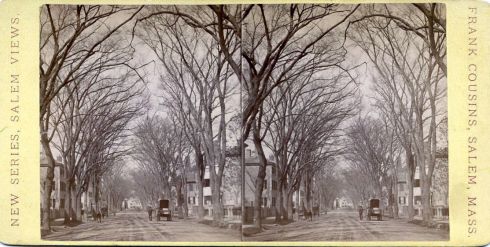This is not to complain–I know lots of good Salem people are working on this–but rather to offer some perspective: Salem’s grand boulevard Lafayette Street needs some trees (and some love). This is the route on which I walk to work nearly every day, and I crave the protective canopy it once had. I’m also tired of picking up trash, and hoping that the commitment to the future that tree plantings represent would also instill a bit more stewardship for this once-grand street. Lafayette Street was laid out a bit later than the rest of Salem: over the course of the nineteenth century following the erection of a bridge to Marblehead and the partition of the vast farm of Ezekiel Hersey Derby. The earliest photographs I have seen are from the 1870s: they show a boulevard of mansions, and trees: elms of course, but also other varieties. We have very precise dating for the planting of the elms of upper Lafayette Street from a wonderful book, John Robinson’s Our Trees. A Popular Account of the Trees in the Streets and Gardens of Salem, and of the Native Trees of Essex County, Massachusetts, with the Locations of Trees, and Historical and Botanical Notes (1891): It has been said that the trees on the upper portion of Lafayette Street were planted within the line of the Derby estate, on account of some opposition to placing them in the street itself. The street was laid out in its present magnificent width at the suggestion of Mr. E. Hersey Derby in 1808. Mr. David Waters informs me that his father, but a short time before his death, while passing these trees, said that when a boy he was called by Mr. Derby to assist at planting them, holding the samplings while the workers filled the earth in about them. Mr. Waters, Senior, was born in 1796 and would have been twelve years of age when the street was laid out. The date of the planting of these elms, thus corroborated, may, therefore, safely be placed at 1808. In addition to a few images of the entire tree-lined street, we also have several photographs of the “wooded estates and pleasure gardens” (a phrase from an 1873 guidebook to greater Boston) of Lafayette Street before the Great Salem Fire of 1914. When you compare these lush images with those taken in the days after the Fire, it’s painful.





Shades of pre-fire Lafayette Street: a very popular postcard c. 1910; Frank Cousins’ photographs of the very verdant street (1876) and the Old Derby Mansion (1891), demolished in 1898, Duke University Library; Gothic Revival and Victorian houses on upper Lafayette, still standing, while the McIntire-designed Josiah Dow House (built 1809) in the lower-right hand corner is gone (Smithsonian Institution collections and Cornell University Library); rendering for the Lafayette Street Methodist Church, American Architecture and Building News, 1884.
The Fire laid waste to half of the street (from Derby to Holly and Leach Streets), and later on many of the surviving mansions of the other half–rather massive Victorians, Queen Annes, and Italianates–became subdivided and commercialized. After the replacement of some of these structures by some truly terrible mid-century apartment buildings, the Lafayette Street Historic District was created in 1985. Trees will really help Lafayette Street, but other challenges remain: chiefly the constant traffic which seems to grow worse and worse with every passing year and the incremental though persistent expansion of Salem State University (my employer) at its upper end. Students and staff have turned this end of Lafayette into one big parking lot, a trend that has not been mediated by the construction of a large campus parking lot in my estimation. I think a new South Salem train stop would help with the parking, but I’m not sure about the traffic: I watch it every day on my way to and from work and the majority of it does not seem to be university-related: this is also the only route to Marblehead, after all.
Traffic is tough, but more trees will shield and shade Lafayette Streets residents…and walkers. And as I said at the top, there are plans for more trees, and better maintenance of existing trees, throughout Salem. Just last week the City Council formed the Leaf-oriented Resiliency and Arboricultural Expansion Taskforce with its associated acronym, LORAX, for just that purpose (yes, you read that correctly: LORAX). The plans for the major new development at the corner of Lafayette and Loring Streets also have lots of provisions for trees. I’m not really a fan of the new building (which will totally dominate the view from my office) but I’m really happy to see plans for all these new trees, including some disease-resistant elms (there is one Elm still alive on Lafayette–I think? See below!)





Upper Lafayette in 1908 and today; the 1914 fire was so devastating, in so many ways, and all of the reports reference the lost trees almost as much as the lost buildings: the Rebuilding Commission Report specified many trees–some of which are visible in the 1917 photograph above: if trees were a priority then, they should be a priority now! Lafayette’s surviving Elm, near the corner of Fairfield Street.
Like this:
Like Loading...











































